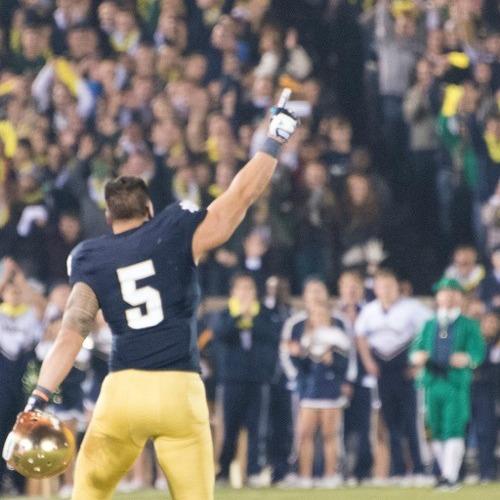BOB GARFIELD: On Wednesday morning, Manti Te'o was best known as a star football player at Notre Dame, a probable NFL first round draft pick, and the college athlete with the world’s most compelling back story.
REPORTER: What makes his performance all the more remarkable is that he did it while enduring almost unimaginable anguish. Last September, his beloved grandmother died of cancer and, on the same day, just hours later, his girlfriend, Lennay Kekua, died after a long battle with leukemia.
BOB GARFIELD: Te’o’s athletic prowess and the odds he’d overcome put him on ESPN and on the cover of Sports Illustrated, beneath the headline, “The Full Manti.” The story of the tragic, remarkable linebacker resounded outside the sports press, picked up by national outlets such as CBS News, the New York Times and the Associated Press. It had all the melodrama of a perfect “Friday Night Lights” plotline.
REPORTER: Te’o says she asked him not to attend her funeral, telling him, “Babe, if anything happens to me, you promise that you’ll stay there and you’ll play and you’ll honor me through the way you play.” And that is what he did.
SPORTSCASTER: In the close win against Michigan, Te’o intercepted two passes. And he did it in the same day that Lennay was buried.
MANTI TE’O: I literally felt them with me.
BOB GARFIELD: And then Wednesday night, the sports feature website Deadspin posted an exposé which asked readers: Did you enjoy the uplifting story, the tale of a man who responded to adversity by becoming one of the top players of the game? If so, stop reading.
BROOKE GLADSTONE: Deadspin reported that Lennay Kekua, the girlfriend, was a hoax, easily debunked using the most basic tools of journalism. There was no obituary, no sign of her in the registrar at Stanford, her supposed college, nor mention of her in the school newspaper, no birth record, for that matter. The only evidence she’d existed was a flimsy social media presence, posted pictures, supposedly of her, but actually of a 22-year-old unaware of the hoax.
Pete Thamel, the Sports Illustrated reporter who wrote the cover story that helped mint the legend, went on the Dan Patrick sports radio show to explain why he fell for it. There was so much detail, he said, that it didn’t occur to him that it could be a big lie.
PETE THAMEL: Well, when those little red flags – oh, she didn’t show up in Nexis, oh, I can’t find her brother’s name to spell check it, like – it just – you know, you, you were able to write around it because you had a whole football team, university community and country. She’s been, quote, unquote, “dead” for a week by the time I got there.
BROOKE GLADSTONE: Now, both Notre Dame and Manti Te’o himself have released statements saying that they were hoaxed by a third party and only learned that the girlfriend was fictional last month. Of course, to believe that you have to believe that Te’o only communicated with her over the phone and online, even though his father described in detail, in the South Bend Tribune, the moment that Te’o and Kekua first met in person.
So now, the media are awash in speculation about whether Te’o was a victim or a perpetrator, or some combination of the two, and also awash in handwringing over this latest high profile example of major media outlets passing along bad information, because other media outlets did it first. But probably it was inevitable because, as in the Lance Armstrong case, it met the ever-present expectation of the audience for a feel good story that transcends mere sport.
Yes, at best, Manti Te’o was a sucker. And the news organizations that unquestionably passed along the story were suckers too. But, of course, so were we, so eager to swallow that bittersweet saga, because it tasted so good.

